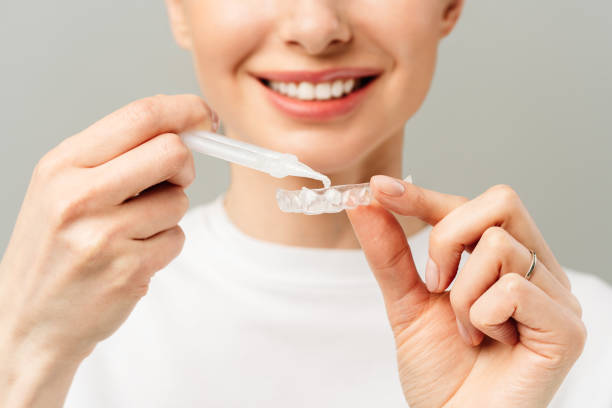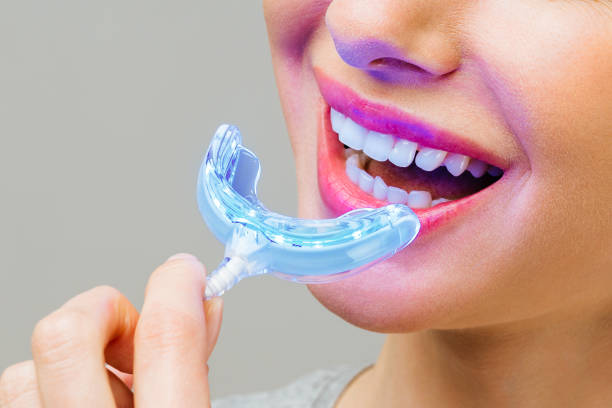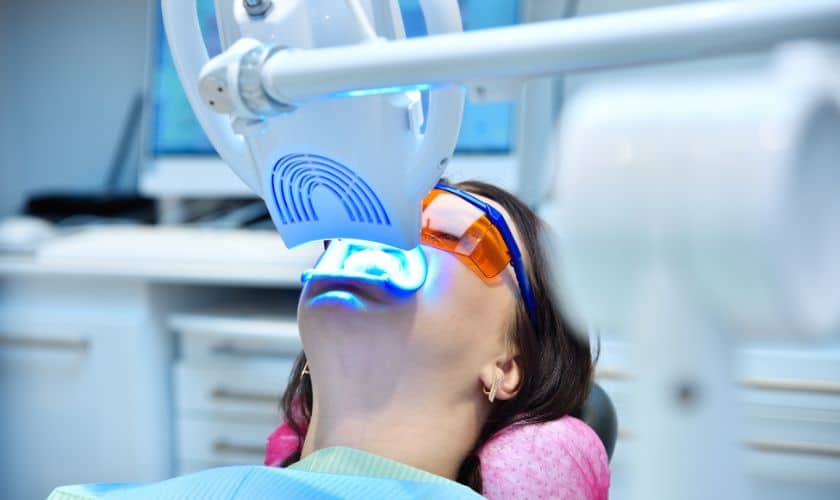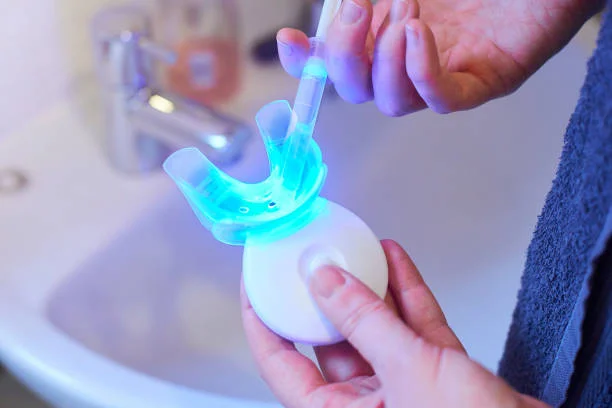A bright smile often feels like the quickest way to boost confidence, but with the number of at-home whitening kits flooding the market, patients frequently ask: “Are these nano whitening kits really effective, or just a passing trend?”
To answer this, we’ll break down how nano teeth whitening technology works, what makes it different from professional whitening, and whether it delivers lasting, safe results for your teeth and gums.
Understanding the science behind nano whitening

Nano whitening refers to a method that uses nanoparticles, extremely small particles, often of hydroxyapatite, titanium dioxide, or silica, to penetrate micro-pores in the enamel. Instead of only removing surface stains like traditional peroxide-based gels, nano formulas claim to restructure and smooth enamel, improving light reflection and giving teeth a whiter appearance.
How it’s supposed to work
- Nano-sized hydroxyapatite fills microscopic irregularities in enamel caused by wear, acid erosion, or mechanical brushing.
- Nano titanium dioxide acts as a mild photocatalyst when exposed to light, enhancing the breakdown of organic stains.
- Some kits include low-concentration hydrogen peroxide or carbamide peroxide, aiming for dual action: stain oxidation and enamel remineralization.
This approach theoretically offers both cosmetic and structural benefits, but the results depend heavily on formulation, particle size, and user compliance.
How do at-home nano whitening kits compare to professional whitening?
At Al Safwa Medical Center in Abu Dhabi, professional whitening systems such as Zoom Whitening or Emax Whitening are controlled by dental specialists who adjust light intensity, peroxide concentration, and exposure time according to the patient’s enamel thickness and sensitivity.
By contrast, at-home kits are standardized, offering lower peroxide levels (typically 0.1–6 percent versus 25–35 percent in clinics). This makes them safer for general consumers but limits their whitening power.
| Feature | Professional whitening (Al Safwa) | At-home nano kit |
| Supervision | Dentist-supervised | Self-applied |
| Whitening agents | Medical-grade hydrogen peroxide, Emax gel | Low-strength peroxide or nano hydroxyapatite |
| Duration | 1–2 sessions | 10–20 days continuous use |
| Average shade improvement | Up to 8 shades lighter | 1–2 shades lighter |
| Longevity | 12–18 months | 2–3 months |
| Safety control | Gum barriers, desensitizers | Variable |
This comparison reveals the main concern: effectiveness versus control. Without clinical supervision, overuse or improper application of home kits can irritate gingival tissue or dehydrate enamel.
Do nano whitening kits actually remove intrinsic stains?
Not entirely. Most intrinsic stains, those within the dentin layer, stem from tetracycline exposure, fluorosis, or trauma-related discoloration. Nano particles act primarily on enamel surface, so they cannot reach deeper layers without chemical oxidation.
For such intrinsic discoloration, dentists at Al Safwa often recommend:
- Internal bleaching for non-vital teeth.
- Porcelain veneers (Emax) for severe discoloration.
- Combined whitening protocols (clinic + home trays) under supervision.
Thus, nano whitening kits can improve enamel reflection and brightness but cannot fully correct dentin-based color changes.
How safe are nano whitening kits for enamel and gums?
Safety depends on formulation quality, application duration, and oral condition.
High-quality nano formulations that are fluoride-free and pH-balanced may reinforce enamel microstructure. However, many over-the-counter brands lack clinical validation.
Potential risks
- Gingival irritation: poorly fitting mouth trays allow gel leakage.
- Tooth sensitivity: dehydration of enamel during whitening.
- Uneven results: patchy appearance in areas with pre-existing restorations.
- Enamel abrasion: if combined with abrasive toothpastes or LED-light overexposure.
Dentists at Al Safwa typically recommend an in-office assessment before using any whitening product, especially for patients with receding gums, dentin hypersensitivity, or multiple restorations.
What results can patients expect from whitening kits?

Results vary widely. Clinical observations show:
- Mild whitening effect (1–2 shade difference) after 2 weeks of daily use.
- Temporary smoothness and gloss due to hydroxyapatite filling.
- Minimal improvement in deep stains or yellowish dentin.
Most patients notice the brightness fades within 6–8 weeks unless maintained by professional cleaning or periodic whitening. Therefore, dentists may suggest using nano kits as maintenance after an in-office whitening session rather than as a primary whitening method.
Can nano whitening replace professional whitening treatments?
Clinically, no. Nano whitening is an adjunct, not an alternative.
Dentists use it to maintain and prolong results following Zoom, Emax, or laser whitening sessions.
At Al Safwa, for example, patients who undergo Zoom Whitening are often provided with a custom take-home kit containing nano-hydroxyapatite serum to reinforce enamel and minimize post-treatment sensitivity.
The controlled approach allows:
- Faster recovery of enamel hydration.
- Sustained shade stability.
- Reduced risk of relapse or surface roughness.
When is nano whitening contraindicated?
Dentists caution against using nano kits if you have:
- Active caries or untreated cavities
- Severe gum recession or periodontal pockets
- Cracked enamel or large composite fillings
- Pregnancy or breastfeeding (due to lack of safety data)
Instead, a clinical whitening plan should begin with comprehensive scaling and polishing, followed by enamel conditioning using fluoride varnish or remineralization therapy, available at Al Safwa’s general dentistry department.
How do dentists at Al Safwa perform nano whitening in-clinic?

Al Safwa Medical Center offers Emax Nano Whitening, a controlled system that uses nano-hydroxyapatite gel activated by a cold-light accelerator. This differs from home kits in several ways:
- Customized concentration: The dentist adjusts nano compound density based on enamel thickness.
- Soft tissue protection: Isolation barriers prevent gum irritation.
- Simultaneous desensitization: Integrated potassium nitrate and calcium phosphate formulas stabilize enamel.
- Immediate results: Two sessions can achieve up to 6–8 shade improvement.
This professional protocol not only whitens but also enhances tooth microstructure integrity, reducing post-treatment sensitivity, something home kits cannot achieve.
What are the advantages of professional whitening at Al Safwa?
- Predictable shade outcome: Measured with a spectrophotometer.
- Long-term enamel strengthening: Continuous remineralization post-treatment.
- Minimal dehydration risk: Controlled exposure under LED light.
- Comfortable experience: Temperature-regulated gel to prevent pulp stress.
- Integrated follow-up: Optional review after 7 days to monitor results.
Are LED and nano whitening the same thing?
No. LED whitening refers to light activation of hydrogen peroxide gels, while nano whitening focuses on mineral-based micro-repair. Many commercial kits combine both but with inconsistent results.
A genuine whitening treatment (as provided at Al Safwa) prioritizes enamel health and longevity over aggressive bleaching.
Maintaining whitening results after treatment
Even the most effective whitening fades over time due to diet, age, and oral habits. To preserve results, Al Safwa’s dental team advises:
- Professional scaling and polishing every 6 months.
- Avoiding pigmented beverages (coffee, tea, red wine) during the first 48 hours.
- Using nano-hydroxyapatite toothpaste to maintain the glossy surface.
- Fluoride rinses to strengthen enamel.
- Customized whitening trays for occasional touch-ups.
Combining home maintenance with clinical follow-ups ensures the whitening effect remains even and natural.
What alternatives exist for patients unsatisfied with at-home results?
If results from at-home whitening are minimal, the following cosmetic dentistry solutions at Al Safwa Medical Center may be more suitable:
- Porcelain veneers (Emax veneers) for permanent whitening and shape correction.
- Dental bonding for localized discolorations or enamel defects.
- Orthodontic correction (Invisalign or ceramic braces) to align teeth for uniform shade distribution.
- Gum depigmentation or laser therapy for dark gingival tissue.
These treatments provide a customized aesthetic solution that surpasses what any store-bought whitening kit can deliver.
The clinical takeaway
While at-home nano whitening kits offer mild, temporary brightness with lower risk than traditional peroxide bleaching, their results remain superficial and short-lived.
For patients seeking measurable, lasting, and safe whitening, professional supervision is indispensable.
At Al Safwa Medical Center, each whitening plan begins with a comprehensive dental evaluation, ensuring the chosen method aligns with your enamel type, gum health, and long-term oral goals.
Conclusion
Nano whitening represents a promising evolution in enamel care, bridging cosmetic enhancement and remineralization. However, its success depends on scientific formulation and clinical supervision.
Patients can explore a variety of whitening options, from Zoom and Emax Nano Whitening to customized home maintenance kits, by consulting the experts at www.alsafwamedical.ae.
Understanding the true capabilities of each whitening approach ensures safer, brighter smiles, supported by evidence, not marketing hype.

